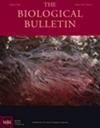Growth and Cyclin-E Expression in the Stony Coral Species Orbicella faveolata Post-Microfragmentation
IF 1.9
4区 生物学
Q2 BIOLOGY
引用次数: 1
Abstract
Coral growth is critical to reef health, resilience under rapidly changing environmental conditions, and restoration efforts. Although fragmenting coral has been occurring for many years in an effort to restore reefs, recently it was discovered that microfragmenting, the process of cutting one piece of coral into many small pieces (about three to five polyps), induces exponential growth. Our study investigates the process by which microfragments of nine different genotypes from the stony coral species Orbicella faveolata grow and exhibit Cyclin-E expression. Microfragments were examined by using a high-powered dissecting microscope with a camera to document the precise areas of tissue exhibiting exponential growth. We found that new polyp formation occurs only on the microfragment edges and that edge polyp growth rates varied between different genotypes. We then extracted tissue from both the edge and the center of five genotypes for genetic analysis. We chose to analyze Cyclin-E expression because it is involved with stimulating mitotic division and is a conserved signaling pathway that is known to exist in Drosophila, mammals, and Cnidaria. Two primers for Cyclin-E were utilized to examine the level of expression for center and edge tissue. We found that Cyclin-E is expressed differentially between O. faveolata polyps, with a tendency for increased expression of the Cyclin-E in edge versus center tissue in each of five genotypes, although this result was not significant. Despite consistently higher levels of Cyclin-E expression within an organism’s edge tissue, genotypes varied significantly in the degree of increased expression. This variation positively correlated with growth rate, suggesting the potential for molecular selection in aid of more rapid reef restoration. Future work will focus on deciphering the specific growth pathways involved in microfragmented coral growth and analyzing expression patterns in injured tissues.石珊瑚小球藻微粉碎后的生长和细胞周期蛋白E的表达
珊瑚生长对珊瑚礁的健康、在快速变化的环境条件下的恢复能力以及恢复工作至关重要。尽管多年来,为了恢复珊瑚礁,珊瑚碎片一直在发生,但最近人们发现,微碎片,即将一块珊瑚切割成许多小块(大约三到五个珊瑚虫)的过程,会导致指数级增长。我们的研究调查了来自石珊瑚物种蚕豆Orbicella favoolata的九种不同基因型的微碎片生长并表现出Cyclin-E表达的过程。通过使用带相机的高倍解剖显微镜检查微碎片,以记录显示指数生长的组织的精确区域。我们发现,新的息肉形成仅发生在微碎片边缘,不同基因型的边缘息肉生长率不同。然后,我们从五种基因型的边缘和中心提取组织进行遗传分析。我们之所以选择分析Cyclin-E的表达,是因为它参与刺激有丝分裂,并且是一种已知存在于果蝇、哺乳动物和刺胞菌中的保守信号通路。使用Cyclin-E的两个引物来检测中心和边缘组织的表达水平。我们发现,细胞周期蛋白E在蚕豆息肉之间表达不同,在五种基因型中,每种基因型的边缘组织和中心组织中细胞周期蛋白-E的表达都有增加的趋势,尽管这一结果并不显著。尽管细胞周期蛋白E在生物体边缘组织中的表达水平一直较高,但基因型的表达增加程度差异显著。这种变化与生长速率呈正相关,表明分子选择有助于更快地恢复珊瑚礁的潜力。未来的工作将集中在破译微碎片珊瑚生长中涉及的特定生长途径,并分析损伤组织中的表达模式。
本文章由计算机程序翻译,如有差异,请以英文原文为准。
求助全文
约1分钟内获得全文
求助全文
来源期刊

Biological Bulletin
生物-海洋与淡水生物学
CiteScore
3.30
自引率
6.20%
发文量
47
审稿时长
6-12 weeks
期刊介绍:
The Biological Bulletin disseminates novel scientific results in broadly related fields of biology in keeping with more than 100 years of a tradition of excellence. The Bulletin publishes outstanding original research with an overarching goal of explaining how organisms develop, function, and evolve in their natural environments. To that end, the journal publishes papers in the fields of Neurobiology and Behavior, Physiology and Biomechanics, Ecology and Evolution, Development and Reproduction, Cell Biology, Symbiosis and Systematics. The Bulletin emphasizes basic research on marine model systems but includes articles of an interdisciplinary nature when appropriate.
 求助内容:
求助内容: 应助结果提醒方式:
应助结果提醒方式:


